
PUBLICATIONS
Published works

Community engagement in the post-disaster landscape
| Title | Community engagement in the post-disaster landscape |
| Publication Type | Thesis |
| Year of Publication | 2018 |
| Authors | D'Arcy, Z |
| Academic Department | School of Architecture and Design |
| Degree | Masters in Disaster, Design and Development |
| Date Published | 07/2018 |
| University | RMIT University |
| Thesis Type | Masters |
| Keywords | community, engagement, post-disaster |
| Abstract | The Hotspots Fire Project is a program providing landholders and land managers with the skills and knowledge to actively participate in fire management. It teaches how fire can be used as a land management technique to promote biodiversity, as well as to protect assets. Hotspots Fire Project is run jointly by the NSW Rural Fire Service (NSW RFS) and the Nature Conservation Council of NSW (NCC). It is steered by a Committee which includes representatives from the following organisations: NCC; NSW RFS; Southeast Queensland Fire and Biodiversity Consortium; Forestry Corporation; Local Government NSW; Local Land Services; Office of Environment and Heritage; NSW National Parks and Wildlife Service; and NSW Farmers. Hotspots was recently run for residents of Carwoola NSW. Carwoola is a peri-urban area located just outside Canberra. In February 2017, the area was impacted by a major bush fire, which burnt 3,134 hectares of land and destroyed over 50 buildings – 11 of them houses. This is the first time the Hotspots program has been run as a recovery tool for a disaster-affected community. The program was adapted for Carwoola to include: two series of two-day workshops for residents; a third workshop day that was also a community café session; training for local Stoney Creek (now Carwoola) RFS brigade to conduct bush fire risk assessments for houses; and on ongoing monthly community café with information sessions. Workshop activities and messaging were adapted to address fears of fire. Local land-holders were encouraged to see fire as an integral part of the Australian landscape, and possibly as a useful land management tool. The overall aim was to make Carwoola’s residents and landscape more resilient to future bush fires. Demand for the Hotspots program – in particular the workshops and property risk assessments – was high to begin with. Fifteen months after the fire, interest from the community has waned. This report looks at the Hotspots program with the view to identifying what worked and areas for improvement. Demand for post-disaster services is likely to increase given the increasing numbers of disasters. Understanding how all these elements come into play, along with sharing beneficial information and support is fundamental to future government programs offering post-disaster assistance. |
Published Works


